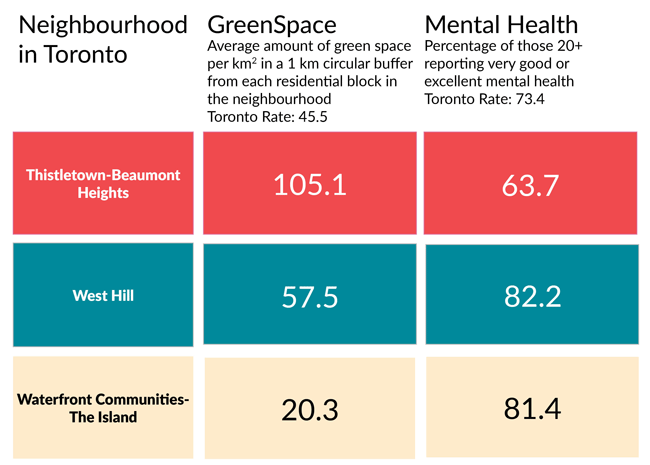Some neighbourhoods in Toronto with high amounts of green space have some of the poorest mental health. This is contrary to the evidence that demonstrates that green spaces have a positive effect on mental health and well-being, so we need to think about what is happening in these spaces.
If you’ve ever walked through High Park in mid-July, you can probably attest to feeling good surrounded by all those trees. Looking around, you’ll notice that in general, people like parks. Think about all the different types of green spaces in Toronto that range from parks and ravines to community gardens. Wouldn’t it be great if everyone could enjoy these spaces? But there’s a problem. Not everyone has access to a green space. And not every green space is a good one.
Accessibility of a space involves considering how people can actually get into the space (whether by walking, cycling or other means of transport) and how they can move around it once they get there. If a green space is fenced off, it doesn’t matter if it is one minute away from where you live. Can seniors, children and those with accessibility needs use the space? After all, if a green space can have a positive impact on your mental well-being, then you need to be able to actually use it to reap any benefits.
Intuitively, it makes sense that even if a neighbourhood has a large, accessible park, but that space is poorly maintained, littered and considered unsafe, it is unlikely to be used. These aren’t generally accepted features of a good quality park. Ideally, a good park has a sense of community and access to washrooms and other amenities, like Dufferin Grove Park. It also needs to be well-lit and not isolated so it’s considered a safe place to be. A good park allows people to connect with nature like Don Valley Brick Works Park. Good parks can also arise from revitalization efforts and become community hubs, like Corktown Common.
In the neighbourhood of Thistletown-Beaumont Heights there is higher than average amounts of green space but only 63.7 percent of residents reported good or excellent mental health. Conversely, in West Hill there is about an average amount of green space with 82.2 percent reporting excellent mental health (Urban HEART Data).
What is going on? It could be that the quality of these green spaces is not high, or that they are inaccessible, or both.
The problem is that measuring quality of green space is not a simple thing to do in a city like Toronto. There are various types of green space, at a range of scales, serving different populations, with different services and in different environments, like urban versus suburban. A process for evaluating quality needs to be adaptable to context. In the Waterfront Communities-The Island neighbourhood for example, perhaps it is the lake (i.e. blue space) that makes up for the lack of green space and accounts for high mental health. We don’t really know, because we don’t have the right measures yet.
Other factors like income, employment, race, age, and education also impact mental health and serve as confounding factors in understanding the relationship between green space and mental health. These underlying, root causes of health issues intersect and need to be considered when thinking about the relationship between green space and mental health.
As a Junior Fellow at the Wellesley Institute, my project explores how the various aspects of green space (quantity of and quality of green space and access to green space) affect mental health. A better understanding of the nuanced factors involved in the built environment of neighbourhoods will contribute to truly creating strong neighbourhoods in Toronto and improving mental health through more accessible and better quality green spaces.

